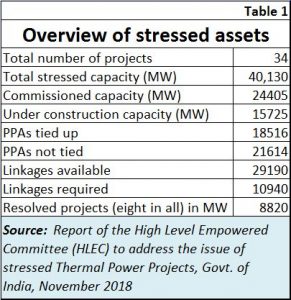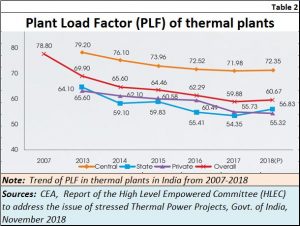https://www.moneycontrol.com/news/business/opinion-strained-finances-of-stressed-thermal-assets-wholl-bell-the-cat-3218511.html
Stressed thermal assets and strained finances
RN Bhaskar — Nov 26, 2018
On November 12, the government of India received the Report of the High Level Empowered Committee (HLEC) to address the issue of stressed Thermal Power Projects in India. The recommendations are far-reaching. The big question is, will they be effected? IUn view of the expected disruption in the power sector, they ought to be (http://www.moneycontrol.com/news/business/a-huge-transformation-of-the-power-sector-can-be-expected-2500499.html).
 Chairing the 12-member committee which formed the HLEC was P.K.Sinha, cabinet secretary, government of India. Other members included representatives from the power, finance, railways, oil & petroleum and coal ministries, and from the two largest banks in India – the SBI and ICICI.
Chairing the 12-member committee which formed the HLEC was P.K.Sinha, cabinet secretary, government of India. Other members included representatives from the power, finance, railways, oil & petroleum and coal ministries, and from the two largest banks in India – the SBI and ICICI.
The issue that is sought to be addressed is that of stressed assets of thermal power plants. As many as 34 plants fall in this category (see table 1)
Together they represent a capacity of 40,130 MW. Assuming an average cost of Rs.6 crore per MW (in many cases it is much higher), this meant that Rs.2.4 lakh crore of investment funds are in jeopardy. Since banks contribute to at least 75% of the project cost, it could mean that at least Rs. 1.8 lakh crore of bank funds are under stress. That explains banks being included in the HLEC.
Although the report does not mention it, it is well known that stressed thermal power plants are in trouble on account of several reasons.
 The first was clearly on account of collusion at the highest levels. Power plants were set up in places where no fuel linkages had been planned.
The first was clearly on account of collusion at the highest levels. Power plants were set up in places where no fuel linkages had been planned.
The second category included plants which were either not designed well, or had substandard machinery.
It is the third type of plants that are salvageable. That list has not been provided by the HLEC. These were reasonably well designed plants, but which could not reach commercial viability either because they were set up without power purchase agreements (PPAs) in place, or because of disputed PPAs because of a change in ground realities, or because coal mines that they thought they would have access to were not longer available. This could have been because of the verdict of the Supreme Court which had overruled out-of-turn and non-transparent allocation of coal mines to private players.
That could explain why the first issue addressed in the report relates to fuel linkages. The report mentions that priority would be given to providing those linkages. That facility could salvage some of the power plants. As of now, one does not know how many of the 26 plants (34 plants less 8 which have got resolved) will be the next plants to become commercially viable.
The issue of PPAs is equally vexing. Some entrepreneurs decided to set up merchant plants which could sell their power directly on the energy exchange. They were seduced by high energy prices on energy exchanges, before the regulator stepped in to put a cap on (mostly) collusively rigged high prices. Once that windfall-bonanza was lost, some entrepreneurs hurriedly persuaded state governments to enter into irregular PPAs, while some thought that they could ride out the storm. Both types of plants could be in trouble. Once again, it is not yet certain how many plants are in this category.
But the HLEC has recommended measures to alleviate this problem. They include allocation and supply of coal for short term PPAs, resuming coal supply in case of termination of PPAs due to default in payment by distribution companies (discoms), getting PSUs to work as aggregator of power, increasing the quantity of coal for special forward e-auction for power sector (this could mean lower revenues for shareholders of Coal India) and retirement of old and inefficient plants
The phasing out of old plants will have the salutary effect of allowing this sector’s plant load factor (PLF) to go up (see chart). A low PLF is indicative of poor utilization of assets, hence a bigger drain on expenses. The HLEC clearly spelt out that the net revenues generated by the suggested measures shall be used entirely for servicing debt in the first place.
The HLEC also recommended issuing advisories to discoms and fuel supply companies for not cancelling any PPA, FSA (fuel supply agreement) and transmission connectivity, environment clearance /forest clearance, even if the project is referred to the National Company Law Tribunal (NCLT). Clearly, the interests of the lenders are of paramount importance.
That is why the recommendations relating to outstandings of state governments are most crucial
The HLEC observed that due to delay in payment by the discoms (most of them are state owned), the viability of the generators get hurt severely. Power regulators and the centre and the states are now being asked to play an additional role. The HLEC recommended that the ministry of power should advise power regulators to monitor payments by discoms and frame appropriate regulations.
The HLEC has sought to curb the tendency of state discoms of not paying the applicable late payment surchanges/penalties (LPS) on delayed payments, despite this being specified in the PPAs. The Committee wants the power ministry to advise power regulators to ensure that LPS is mandatorily paid by discoms in the event of delay in payment.
Another issue is the inability of state discoms to make timely payments to generators because of their poor financial health. One recommendation is that Public Financial Institutions (PFIs), such as REC and PFC may discount the receivables from discoms and then make up-front payment to generators. The PFIs can realise their dues from the state discoms after charging interest for the period of delay in payment, But the PFIs expressed little confidence in recovering such dues. They want the bill discounting facility to be covered by a Tripartite agreement (TPA) involving the generator, discom and the Reserve Bank of India (RBI). In event of a default, the RBI could step in and recover the dues from the account of state governments and reimburse the PFIs. A proposal to this effect is to be made.
The idea is good, but the big question is whether such a law can be passed. One way out could be to dismantle state power grids for rural areas (http://www.moneycontrol.com/news/business/dear-pm-modi-heres-how-bureaucrats-are-planning-to-scuttle-your-rooftop-solar-employment-plans-2468501.html) . Instead allow private entrepreneur-driven distributed-clusters of dencentralised power generation and distribution using solar and methane (https://www.moneycontrol.com/news/business/economy/comment-the-spinoff-from-swachh-bharat-wealth-from-waste-could-be-big-sht-2556797.html). The thermal power generation companies could still provide power to industry and high tension users.
That would reduce India’s need to set up additional thermal plants. It could then focus on rooftop solar – a cleaner fuel. It would address the employment problem, reduce the import bill, and even solve the problem of discoms being reckless in paying power generation companies their dues (http://www.moneycontrol.com/news/business/economy/the-radical-power-for-all-solution-that-the-government-should-adopt-2396605.html).
Since power generation companies will be allowed to directly supply power to nearby industry and businesses, that could mean lower costs for industry and business, a spur to economic activity and a resolution to stressed assets.
The problem, as always, will be — who will bell the cat?







































COMMENTS